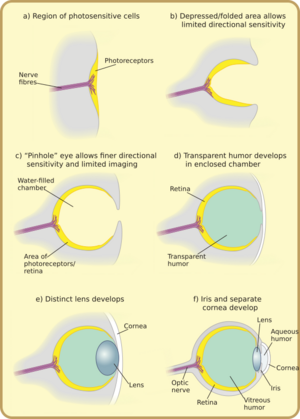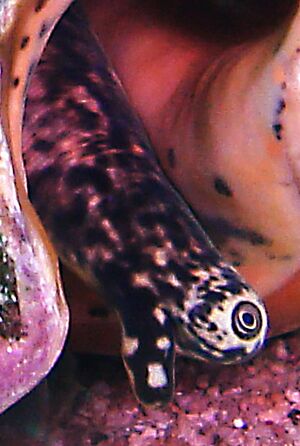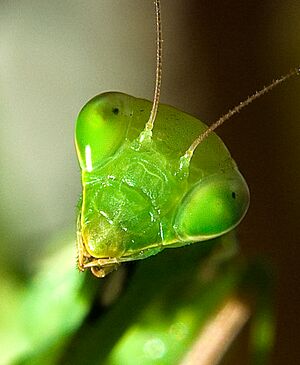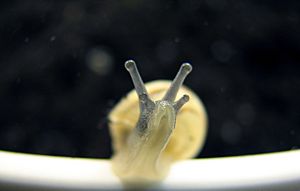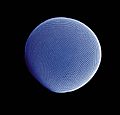Evolution of the eye facts for kids

The evolution of the eye explains how eyes have changed over millions of years. Eyes are a type of organ that many different animals have. This means they are a homologous organ.
Some parts of the eye, like the special chemicals that sense light (called visual pigments), seem to have come from one common ancestor. This means they first appeared once, a very long time ago. Then, animals spread out and developed in many different ways.
However, complex eyes that can form clear images have actually evolved many times. Scientists think this happened about 50 to 100 times! These different eyes often used similar building blocks, like the same proteins and genes, to develop.
Complex eyes first appeared quickly, within a few million years. This happened during a time of fast evolution called the Cambrian explosion. Before the Cambrian period, there is no clear evidence of eyes. But in the Middle Cambrian period, many different types of eyes suddenly appeared.
Eyes have changed in many ways to help animals survive. They can be different in how clearly they see, what colors they can detect, and how well they see in dim light. Eyes can also vary in how well they spot movement or see small details. Some eyes can even tell the difference between many colors.
How Fast Did Eyes Evolve?
The first signs of eyes in fossils appeared about 540 million years ago. This was during the early Cambrian period. This time saw a quick burst of new life forms, known as the 'Cambrian explosion'. Some scientists believe that the development of eyes started a kind of "race" among animals. This race led to even faster evolution.
Before this time, animals might have been able to sense light. But they probably did not need to see clearly for fast movement or finding their way around.
It is hard to know exactly how fast eyes evolved. Simple computer models can help us guess. These models suggest that a basic light-sensing organ could become a complex eye, like a human eye, in about 400,000 years. This would happen through small changes and natural selection.
Early Steps in Eye Evolution
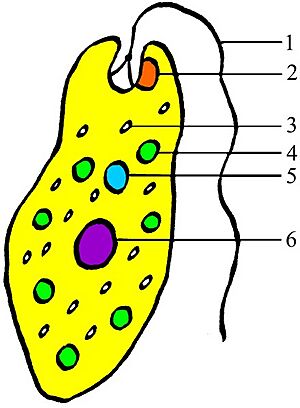
The very first light sensors were simple proteins. These were like tiny eyespots found in very small organisms called protists. These eyespots could only tell the difference between light and dark. This was enough for them to know when it was day or night. This helped them keep their daily body rhythms, called circadian rhythms, on track. However, they could not see shapes or know where the light was coming from.
Eyespots are found in almost all major animal groups. For example, the Euglena has an eyespot called a stigma at its front. This stigma has a red pigment that shades a group of light-sensitive crystals. Along with a tiny tail-like part called a flagellum, the eyespot helps the Euglena move towards light. This helps it make its own food through photosynthesis. It also helps it predict day and night, which is important for its daily rhythms.
In more complex animals, visual pigments are found in their brains. Scientists think these pigments help animals time their breeding with the moon's cycles. By sensing small changes in night-time light, animals could release their sperm and eggs at the same time. This would increase the chance of fertilization.
Vision itself uses basic biochemistry that is similar in all eyes. But how this basic "toolkit" is used to understand an animal's environment varies a lot. Eyes have many different shapes and structures. These different forms evolved much later than the basic proteins and molecules that make them work.
At a tiny cell level, there seem to be two main types of eye designs. One type is found in protostomes, like molluscs, annelid worms, and arthropods. The other type is found in deuterostomes, like chordates (which include humans) and echinoderms.
See also
- Springer Verlag Evolution: Education and Outreach Volume 1, Number 4 / October 2008. Special Issue: The evolution of eyes. 26 articles, restricted access.
Images for kids
-
The planarian has "cup" eyespots that can slightly tell where light is coming from.
-
The nautilus eye works like a pinhole camera.
-
The compound eye of Antarctic krill.
See also
 In Spanish: Evolución del ojo para niños
In Spanish: Evolución del ojo para niños


